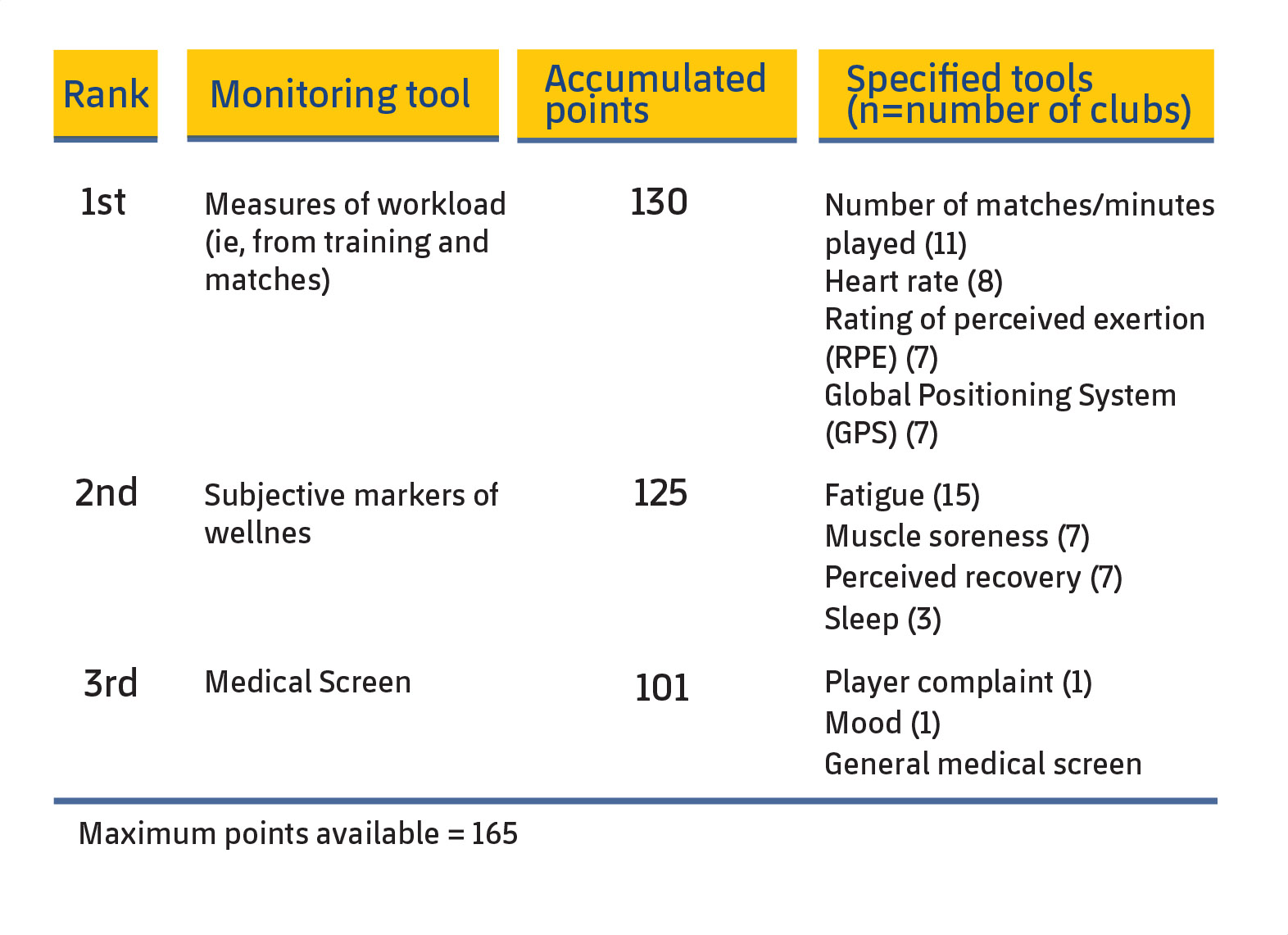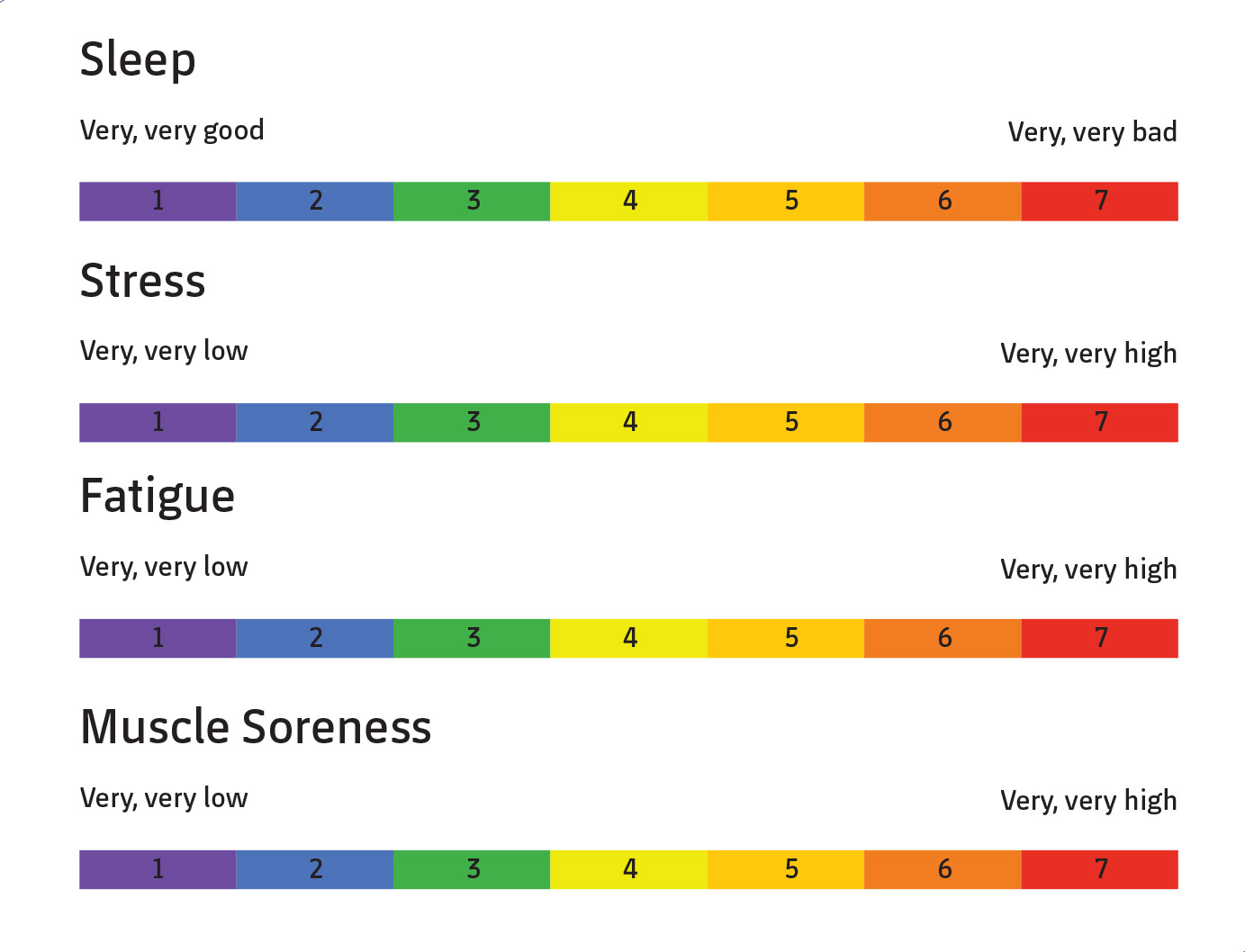July 1, 2019
Medicine
Health and Wellness
Team Sports
THE USE OF WELLNESS QUESTIONNAIRES IN FOOTBALL
Training load (TL) management is a key component for optimising performance. Understanding TL will allow us to evaluate fatigue and to anticipate overload and overtraining in order to minimise injury risk. As there is a relationship between TL and injury incidence (Drew & Finch, 2016), it is therefore important to measure this factor. The quantification of TL aims to analyse adaptations caused by training and reduce the risk of possible side effects from these adaptations, such as non-functional overload and injury (Halson, 2014).
In elite sports, and particularly in football, there is a very fine line between success and failure. A plethora of internal and external factors will determine performance. Monitoring and understanding these factors will help us to assess whether a player is adapting and responding well to a training programme. Monitorising to analyse trends in parameters related to fatigue, can help to make the right adjustments for the player’s condition. Although there are a variety of monitoring devices, such as GPS, pulsometers and lactate meters, we don’t always have access to these devices. However, wellness questionnaires have emerged in recent years as a reliable, economical and easy-to-use method for controlling load responses (Heidari et al., 2019; Saw et al., 2016). These questionnaires depict the player’s perception of his or her stress level and provides information on the TL both from a physiological and psychological standpoint.
The Importance of Wellness Questionnaires
In sports such as football, where each team has 20 to 25 players, it is not viable to talk to each one of them on a daily basis to see how they feel, how they slept, or how fatigued they feel. Wellness questionnaires allows us to obtain this valuable information in a fast, easy-to-process way without requiring an individual conversation with each member of the group. The use of these questionnaires is therefore growing exponentially. In fact, they’re now considered the second most important monitoring tool for injury prevention among the teams’ head medical officers included in the UEFA Elite Club Injury Study (Figure 1) (McCall et al., 2016). Additionally, the assessment of perceived fatigue was the most-analysed variable, while other variables such as muscular pain, perceived recovery level and sleep quality are also being used by leading European football clubs for injury prevention (McCall et al., 2016). And although evidence is still thin on the ground, subjective assessment of fatigue through sleep, stress and rest has been observed to predict injuries in the month following assessment (Laux et al., 2015).

Researchers at Liverpool John Moores University have also observed that in elite football players, wellness questionnaires (subjective assessments of fatigue, sleep quality and muscle damage) are more sensitive to the daily fluctuations of TL when compared to objective fatigue markers such as sub-maximum heart rate (HR), recovery HR or HR variability (Thorpe et al., 2016). The authors also determined that perceived fatigue is related to total distance covered at high intensity (Thorpe et al., 2015, 2017).
Methodological Aspects
There are different types of wellness questionnaires. However, some of these are composed of multiple scales and items, which takes away one of their greatest advantages: speed and simplicity, when handed out and analysed. Xavier Franquesa, strength and conditioning coach for FC Barcelona’s Juvenile B team, explains how the data collection process is quickly carried out: ‘Players receive a mobile phone alert reminding them to fill in the questionnaire before breakfast, and while they eat, we analyse them’. Among the questionnaires that can be shared with speed and ease, we’d like to highlight the Hooper Scale (Hooper & Mackinnon, 1995), based on a subjective analysis of the quality of the previous night’s sleep, stress levels, fatigue levels and perceived muscle damage. Each question is individually scored on a scale from 1 (“Very, very low or good”) to 7 (“Very, very high or bad”). Given its benefits, FC Barcelona currently employs this questionnaire at youth levels, and starting next year, its children’s teams will use it as well (Figure 2).

Once the information has been analysed, the coach is only notified if there is an anomaly. At that point, the day’s training will be modified for that player or a group of players. As Marc Guitart, strength and conditioning coach for Barça B, explains: ‘When a red flag goes up, regardless of whether it’s due to too much or too little work, the coach is notified so that he can determine whether a partial modification—such as using a player as a wild card in some exercises, or keeping him back from others—is sufficient, or if a more specific follow-up is needed. If the data points are too low, perhaps the player needs a little more stimulation through additional work at the end of the training session’.
The assessment is carried out differently at various levels. For example, the strength and conditioning coach for Barça B uses an iPad to ask each player the questions, while youth players fill in the questionnaire themselves using an app built by the club (eKeep), which each player has downloaded onto their smartphone.
However, there are limitations when implementing this sort of tool. For these questionnaires to be reliable, players must internalise the scoring system and be able to differentiate between the numbers, as Marc Guitart tells us: ‘In the beginning, players aren’t able to associate a numerical value with the intensity of their fatigue unless they’ve gone through all of the possible values on the scale, and that’s more of an adaptive process than an educational one’. Finally, it’s vital to explain to players the importance of honesty when responding; in other words, players shouldn’t be concerned about the assessment having an impact on their participation in the next game. As Xavier Franquesa states: ‘From the pre-season onwards, they have to understand that their responses to the questionnaire will not mean that they will play more or less. They need to be honest when answering, and even if they tell us that they have very high levels of muscle damage, that doesn’t mean that they won’t play in the next game. Instead, the physiotherapist will take the appropriate measures to reduce injury risk’.
Conclusions
Ultimately, the process of monitoring and understanding TL—which can be implemented quickly and practically through questionnaires on a phone—will help prescribe the correct dosage of training in order to maximise each player’s performance while minimising injury risk. Moreover, in cases where a high injury risk is identified, it will allow to implement the appropriate recovery protocols (rest, nutrition, stretching, etc.) to reduce the risk.
The Barça Innovation Hub team
REFERENCES:
Drew, M. K., & Finch, C. F. (2016). The relationship between training load and injury, illness and soreness: a systematic and literature review. Sports Med, 46(6), 861-883.
Halson, S. L. (2014). Monitoring training load to understand fatigue in athletes. Sports Med, 44(2), 139-147.
Heidari, J., Beckmann, J., Bertollo, M., Brink, M., Kallus, K. W., Robazza, C., & Kellmann, M. (2019). Multidimensional monitoring of recovery status and implications for performance. Int J Sports Physiol Perform, 14(1), 2-8.
Hooper, S. L. & Mackinnon, L. T. (1995). Monitoring overtraining in athletes. Sports Med, 20(5), 321-327.
Laux, P., Krumm, B., Diers, M., & Flor, H. (2015). Recovery–stress balance and injury risk in professional football players: a prospective study. J Sports Sci, 33(20), 2140-2148.
McCall, A., Dupont, G., & Ekstrand, J. (2016). Injury prevention strategies, coach compliance and player adherence of 33 of the UEFA Elite Club Injury Study teams: a survey of teams’ head medical officers. Br J Sports Med, 50(12), 725-730.
Saw, A. E., Main, L. C., & Gastin, P. B. (2016). Monitoring the athlete training response: subjective self-reported measures trump commonly used objective measures: a systematic review. Br J Sports Med, 50(5), 281-291.
Thorpe, R. T., Strudwick, A. J., Buchheit, M., Atkinson, G., Drust, B., & Gregson, W. (2015). Monitoring fatigue during the in-season competitive phase in elite soccer players. Int J Sports Physiol Perform, 10(8), 958-964.
Thorpe, R. T., Strudwick, A. J., Buchheit, M., Atkinson, G., Drust, B., & Gregson, W. (2016). Tracking morning fatigue status across in-season training weeks in elite soccer players. Int J Sports Physiol Perform, 11(7), 947-952.
Thorpe, R. T., Strudwick, A. J., Buchheit, M., Atkinson, G., Drust, B., & Gregson, W. (2017). The influence of changes in acute training load on daily sensitivity of morning-measured fatigue variables in elite soccer players. Int J Sports Physiol Perform, 12(Suppl 2), S2-107.
KNOW MORE
CATEGORY: MARKETING, COMMUNICATION AND MANAGEMENT
This model looks to the future with the requirements and demands of a new era of stadiums, directed toward improving and fulfilling the experiences of fans and spectators, remembering “feeling” and “passion” when designing their business model.
CATEGORY: FOOTBALL SPORTS PERFORMANCE
Through the use of computer vision we can identify some shortcomings in the body orientation of players in different game situations.
CATEGORY: MEDICINE HEALTH AND WELLNESS
A health check must detect situations which, despite not showing obvious symptoms, may endanger athletes subject to the highest demands.
CATEGORY: FOOTBALL TEAM SPORTS
In the words of Johan Cruyff, “Players, in reality, have the ball for 3 minutes, on average. So, the most important thing is: what do you do during those 87 minutes when you do not have the ball? That is what determines whether you’re a good player or not.”
CATEGORY: MEDICINE HEALTH AND WELLNESS SPORTS PERFORMANCE
Muscle injuries account for more than 30% of all injuries in sports like soccer. Their significance is therefore enormous in terms of training sessions and lost game time.
DO YOU WANT TO KNOW MORE?
- SUBSCRIBE
- CONTACT
- APPLY
KEEP UP TO DATE WITH OUR NEWS
Do you have any questions about Barça Universitas?
- Startup
- Research Center
- Corporate